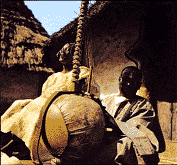|
Guinea Classics: folk and pop Reviews of two collections of Guinean music: Music of the Mandinka - 1952 field recordings Guinée 40ème Anniversaire
Guinea: Music of the Mandinka
This collection represents a pre-pop Mandinkan music, music of Toumani Diabate's father's father, if you will, recorded in small towns in Guinea before the commercial recording industry brought new (and admittedly exciting) changes to the musical landscape. Rouget's excellent notes and photographs allow the listener a deep look into a folk culture that eventually exploded into a vibrant popular music scene. - CF
Guin�e 40�me Anniversaire The Syliphone label dominated the Guinean music scene from the mid-1960s until its demise in 1980. The major works by some of West Africa's most influential bands and musicians of the era were released by Syliphone as part of a total of 82 long play records, all of which have been out of print for many years and are now much sought after by collectors. In celebration of Guinea's 40th anniversary of independence, a 2-volume CD has been released which covers a broad spectrum of the original recordings. The early days of the music scene in Guinea are documented by recordings of Orchestra de la Paillotte, Jardin de Guinée and the Orchestre de la Garde Républicaine. On these tracks the influence of Cuban music is clearly evident, especially in the brass arrangements, yet one can also hear the emerging "modern" styles which would propel many of the state-sponsored ensembles to international fame. Sékou "Diamond Fingers" Diabaté appears on three Bembeya Jazz tracks and most of the material on the compilations features a guitar solo. All of the great bands and musicians are represented, with excellent recordings by Kouyaté Sory Kandia, Balla et ses Balladins, Horoya Band, Camayenne Sofa, Super Boiro Band and South African singer Miriam Makeba (who sought asylum in Guinea in the early 70s). A must for fans of the "golden era" of West African music. - Graeme Counsel
|
 These 1952 recordings are a rich and beautiful look at the music of the Mandinka of what was then French Guinea. Recordist Gilbert Rouget got up close and personal with these recordings, giving them a somewhat flat but immediate sound, emphasizing performance over ambiance. And such performances they are!
These 1952 recordings are a rich and beautiful look at the music of the Mandinka of what was then French Guinea. Recordist Gilbert Rouget got up close and personal with these recordings, giving them a somewhat flat but immediate sound, emphasizing performance over ambiance. And such performances they are!